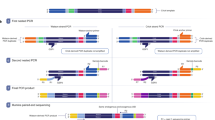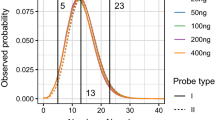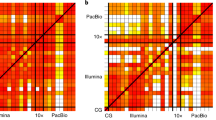Abstract
The detection of sequence variation, for which DNA sequencing has emerged as the most sensitive and automated approach, forms the basis of all genetic analysis. Here we describe and illustrate an algorithm that accurately detects and genotypes SNPs from fluorescence-based sequence data. Because the algorithm focuses particularly on detecting SNPs through the identification of heterozygous individuals, it is especially well suited to the detection of SNPs in diploid samples obtained after DNA amplification. It is substantially more accurate than existing approaches and, notably, provides a useful quantitative measure of its confidence in each potential SNP detected and in each genotype called. Calls assigned the highest confidence are sufficiently reliable to remove the need for manual review in several contexts. For example, for sequence data from 47–90 individuals sequenced on both the forward and reverse strands, the highest-confidence calls from our algorithm detected 93% of all SNPs and 100% of high-frequency SNPs, with no false positive SNPs identified and 99.9% genotyping accuracy. This algorithm is implemented in a software package, PolyPhred version 5.0, which is freely available for academic use.
This is a preview of subscription content, access via your institution
Access options
Subscribe to this journal
Receive 12 print issues and online access
$209.00 per year
only $17.42 per issue
Buy this article
- Purchase on Springer Link
- Instant access to full article PDF
Prices may be subject to local taxes which are calculated during checkout




Similar content being viewed by others
References
Carlson, C.S., Newman, T.L. & Nickerson, D.A. SNPing in the human genome. Curr. Opin. Chem. Biol. 5, 78–85 (2001).
Nickerson, D.A., Tobe, V.O. & Taylor, S.L. PolyPhred: automating the detection and genotyping of single nucleotide substitutions using fluorescence-based resequencing. Nucleic Acids Res. 25, 2745–2751 (1997).
Cargill, M. et al. Characterization of single-nucleotide polymorphisms in coding regions of human genes. Nat. Genet. 22, 231–238 (1999).
Carlson, C.S. et al. Additional SNPs and linkage-disequilibrium analyses are necessary for whole-genome association studies in humans. Nat. Genet. 33, 518–521 (2003).
Marth, G.T. et al. A general approach to single-nucleotide polymorphism discovery. Nat. Genet. 23, 452–456 (1999).
Ning, Z., Cox, A.J. & Mullikin, J.C. SSAHA: a fast search method for large DNA databases. Genome Res. 11, 1725–1729 (2001).
Ewing, B. & Green, P. Base-calling of automated sequencer traces using Phred. II. Error probabilities. Genome Res. 8, 186–194 (1998).
Weckx, S. et al. novoSNP, a novel computational tool for sequence variation discovery. Genome Res. 15, 436–442 (2005).
Kwok, P.Y., Carlson, C., Yager, T.D., Ankener, W. & Nickerson, D.A. Comparative analysis of human DNA variations by fluorescence-based sequencing of PCR products. Genomics 23, 138–144 (1994).
Parker, L.T. et al. AmpliTaq DNA polymerase, FS dye-terminator sequencing: analysis of peak height patterns. Biotechniques 21, 694–699 (1996).
Ewing, B., Hillier, L., Wendl, M.C. & Green, P. Base-calling of automated sequencer traces using Phred. I. accuracy assessment. Genome Res. 8, 175–185 (1998).
Hinds, D.A. et al. Whole-genome patterns of common DNA variation in three human populations. Science 307, 1072–1079 (2005).
The International HapMap Consortium. A haplotype map of the human genome. Nature 437, 1299–1320 (2005).
Bhangale, T.R., Rieder, M.J., Livingston, R.J. & Nickerson, D.A. Comprehensive identification and characterization of diallelic insertion-deletion polymorphisms in 330 human candidate genes. Hum. Mol. Genet. 14, 59–69 (2005).
Olden, K. & Wilson, S. Environmental health and genomics: visions and implications. Nat. Rev. Genet. 1, 149–153 (2000).
Dempster, A.P., Laird, N.M. & Rubin, D.B. Maximum likelihood from incomplete data via the EM algorithm. J. R. Stat. Soc. Ser. B 34, 1–38 (1977).
Gordon, D., Abajian, C. & Green, P. Consed: a graphical tool for sequence finishing. Genome Res. 8, 195–202 (1998).
Acknowledgements
The authors thank past and present members of the Nickerson lab for compiling the databases that were used to develop, train and test our algorithm. This work was supported by US National Institutes of Health (NIH) grants (1RO1HG/LM-02585 to M.S., and ES-15478 and HL-66682 to D.A.N.). P.S. was supported by an NIH training grant (T32 HG00035-06).
Author information
Authors and Affiliations
Corresponding author
Ethics declarations
Competing interests
POLYPHRED is freely available for academic purposes, but a licensing fee is charged for commercial use, which predominantly funds further software and methods development.
Supplementary information
Supplementary Fig. 1
Illustration of how our method removes systematic variation in secondary peak height to improve discrimination between heterozygotes and homozygotes. (PDF 95 kb)
Supplementary Fig. 2
Relationship between score assigned by our method to each genotype and genotyping agreement rate. (PDF 20 kb)
Supplementary Fig. 3
Illustration of tiled and double-coverage sequencing designs. (PDF 23 kb)
Supplementary Fig. 4
Relationship between rates of agreements between genotypes and the percentage of uncalled genotypes, as threshold for calling genotypes varies. (PDF 18 kb)
Rights and permissions
About this article
Cite this article
Stephens, M., Sloan, J., Robertson, P. et al. Automating sequence-based detection and genotyping of SNPs from diploid samples. Nat Genet 38, 375–381 (2006). https://doi.org/10.1038/ng1746
Received:
Accepted:
Published:
Issue Date:
DOI: https://doi.org/10.1038/ng1746
This article is cited by
-
Rare intronic variants of TCF7L2 arising by selective sweeps in an indigenous population from Mexico
BMC Genetics (2016)
-
MSuPDA: A Memory Efficient Algorithm for Sequence Alignment
Interdisciplinary Sciences: Computational Life Sciences (2016)
-
DiSNPindel: improved intra-individual SNP and InDel detection in direct amplicon sequencing of a diploid
BMC Bioinformatics (2015)
-
Investigation of Pathogenic Genes in Chinese sporadic Hypertrophic Cardiomyopathy Patients by Whole Exome Sequencing
Scientific Reports (2015)
-
Performance evaluation of Warshall algorithm and dynamic programming for Markov chain in local sequence alignment
Interdisciplinary Sciences: Computational Life Sciences (2015)



